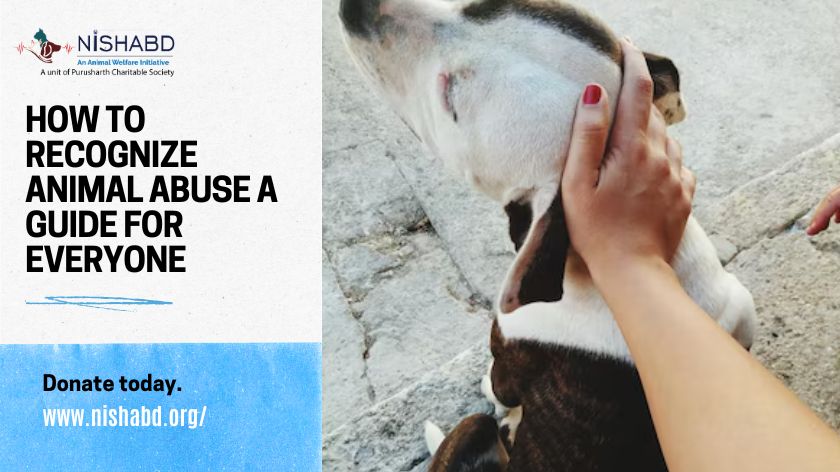How to Recognize Animal Abuse A Guide for Everyone
Animal abuse is an unfortunate reality that affects millions of animals around the world, from neglect, cruelty or harm caused by humans. Knowing how to recognize animal abuse and how to stop animal abuse is essential if we want to protect animals from suffering.
This blog will walk you through the signs of animal abuse and what you can do if you suspect it’s happening.
What is Animal Abuse?
Animal abuse refers to any action which causes harm, suffering or neglect for an animal. It may involve deliberate physical violence as well as neglect resulting from not providing sufficient food, water and shelter – many times people don’t even realize what they’re doing is harmful. That is why it is crucial that individuals become familiar with signs of animal cruelty in order to help animals in need.
Animal abuse occurs everywhere–in homes, neighborhoods, farms and entertainment settings alike. Victimized animals could include pets, farm animals or wildlife that has been mistreated. Recognizing animal abuse is the first step to stopping it–something we all can contribute towards doing together.
Signs of Animal Abuse
One of the most essential skills is being able to identify signs of animal abuse. Animals cannot speak up for themselves, so we owe it to them for us to recognize when something goes amiss.
Here are some indicators of animal mistreatment you should watch out for:
- Physical Injuries: Animals suffering cuts, bruises, burns or broken bones is a sure sign of abuse and should receive medical care immediately. Visible wounds could also indicate pain that requires help to be addressed quickly.
- Emaciation or Starvation: Animals that appear thin may be insufficiently fed, indicating neglect by humans. If you can see their ribs, spine, or hip bones through their fur then this could be evidence of animal abuse due to neglect.
- Poor Living Conditions: Be aware of animals living in environments which are crowded, cramped or dangerous. Animals that reside in small cages for extended periods, don’t receive fresh water and food or are tied up are examples of neglectful treatment and need your help immediately.
- Fearful or Aggressive Behavior: Animals that have been mistreated often display strange behavior, such as cowering from people and hiding, becoming afraid when approached, shaking when handled, becoming aggressive toward humans, or lashing out as a means to express their pain. All are the signs that someone has mistreated the animal.
- Lack of Medical Care: Animal abuse becomes evident when an animal appears sick or injured but doesn’t receive adequate medical attention for treatment. Animals suffering from infections, sores or illness that go unaddressed need immediate intervention from humans in order to receive appropriate medical care and should receive immediate assistance from healthcare providers.
How to Stop Animal Abuse
If you notice the signs of animal abuse, it’s important to know how to stop animal abuse. Here are some ways you can take action to help:
- Report Abuse: If you doubt an animal of being subjected to mistreatment, report it immediately to local authorities, animal control services or animal shelters in order to investigate and take measures necessary for protecting it. Provide as much detail as possible about its location and condition when reporting abuse cases.
- Document What You See: If it is safe, take pictures or videos of the animal and their living conditions. This evidence could prove vital when authorities investigate your case. Additionally, make note of any signs of animal abuse you notice such as injuries, poor living conditions or unusual behavior that you see during this investigation process.
- Get Involved Locally: One effective way to combat animal abuse is by getting involved with local animal protection groups. These organizations like Nishabd work tirelessly to rescue animals and raise awareness about animal abuse. You can support their efforts through donations, volunteering or even foster care of an animal in need.
- Raise Awareness: Raising awareness about animal abuse is key to stopping it. Inform friends, family, and community members about its signs as well as what to do if they suspect abuse. The more people know about animal abuse the higher its chance is that animals will get assistance when needed.
- Advocate for Stronger Laws: One effective long-term way of stopping animal abuse is advocating for stronger laws to protect animals. You can contact your representatives and encourage them to pass stricter animal cruelty legislation that can hold those accountable and stop future abuse.
Understanding and Avoiding Animal Abuse is Crucial
Recognizing and understanding animal abuse are essential in protecting animals. Animals deserve to live without fear, pain or suffering and depend on us as humans to speak up when signs of animal mistreatment appear. By acting upon signs of animal mistreatment we can help animals escape potentially hazardous situations and find care they deserve.
Stopping animal abuse also has many other benefits for our communities. Research shows that individuals who abuse animals tend to also abuse other people. By overcoming cruelty against animals, we’re helping build a safer and kinder world for everyone.
Conclusion
Animal abuse is an ongoing, serious problem that we can all work together to overcome. By understanding the signs of animal abuse – physical injuries, malnutrition, poor living conditions and fearful behavior we can recognize when an animal may be in danger.
If you suspect abuse it is important to know how to report and document what you see to stop this form of animal exploitation as soon as possible in your community so we can protect these creatures while providing them with the care and respect they deserve.

